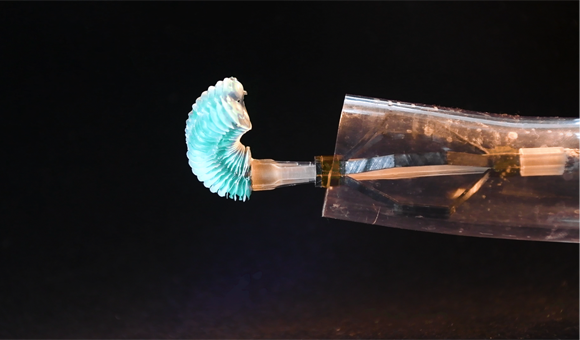
The new robotic catheter features both a deployable stabilization mechanism and a flexible manipulator tip. Image Credit: Rogatinsky et al.
Crafted by a collaboration of physicians and engineers at Boston University, this device boasts shape-shifting capabilities, enabling it to navigate intricate anatomical structures within the heart while ensuring stability to achieve surgical goals.
Highlighted in a Science Advances study, the researchers showcased the robot's efficacy in aiding two simulated cardiac procedures using animal tissue. They posit that with continued refinement, this robotic catheter holds the potential to significantly enhance safety and reduce the strain of numerous routine heart surgeries.
The authors carefully consider patient safety in their design, which creatively integrates several robotic features to navigate an environment that can be complicated and risky to operate in.
Moria Bittmann Ph.D., Director, Robotics Program, National Institute of Biomedical Imaging and Bioengineering
In the United States, a considerable number of cardiac procedures performed today involve open-heart surgeries, providing surgeons with a high level of control. However, these surgeries come with extended recovery periods and may not be viable for high-risk patients. Less invasive methods, utilizing catheters threaded through the body's vasculature to reach the heart, are available but face significant challenges.
Existing instruments, designed to fit through peripheral veins, are easily displaced by the beating heart tissue due to their size and lack of necessary dexterity for precise targeting.
This dilemma has presented a unique challenge for researchers, demanding an instrument with seemingly contradictory properties—being both small and large, rigid and maneuverable.
To address this puzzle, Professor Tommaso Ranzani and his team at Boston University developed a robotic system with adaptive qualities. The robotic catheter features a flexible, air pressure-operated tip thin enough to navigate veins but capable of inflating once inside the heart. To enhance stability, an expandable ring deploys near the heart's entrance, anchoring the catheter in place.
With the inflatable tip and stabilizing mechanism, the researchers aimed to enable the catheter to exert sufficient force to penetrate beating heart tissue without being pushed back. Subsequently, the catheter could retract both its stabilizer and tip for a smooth exit.
Testing the device on a realistic anatomical setting, the researchers performed two cardiac procedures within an ex vivo pig heart's right atrium—the first involving pacemaker lead placement and the second simulating the initial step of a tricuspid valve repair procedure.
In the pacemaker lead placement, five inexperienced operators successfully completed the procedure using the robotic catheter, matching the time taken by an experienced physician with a standard catheter. The robotic tool also proved successful in the tricuspid valve repair simulation, maintaining contact with and applying force to a moving target.
The researchers plan to advance the technology by conducting live experiments on more complex procedures, aiming to reduce the reliance on taxing open-heart surgeries based on the promising outcomes of their robotic catheter system.
As we discuss these results with physicians working in the field, we see a high level of enthusiasm and hear of more and more applications for this technology. I think generally that this strategy is taking us in the right direction.
Tommaso Ranzani, PhD, Study Senior Author and Professor, Mechanical Engineering, Boston University
This study was financially supported by NIBIB (R21EB028363) and the National Center for Advancing Translational Sciences (1UL1TR001430) as well as a Department of Energy GAANN award (P200A210041).
Journal Reference
Rogatinsky, J., et al. (2023) A multifunctional soft robot for cardiac interventions. Science Advances. doi.org/10.1126/sciadv.adi5559.